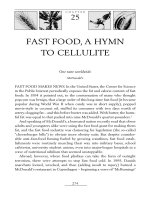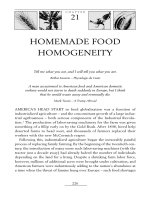HOMEMADE FOOD HOMOGENEITY
Bạn đang xem bản rút gọn của tài liệu. Xem và tải ngay bản đầy đủ của tài liệu tại đây (183.06 KB, 12 trang )
226
CHAPTER
21
HOMEMADE FOOD
HOMOGENEITY
Tell me what you eat, and I will tell you what you are.
Brillat Savarin – Physiologie du Goût
A man accustomed to American food and American domestic
cookery would not starve to death suddenly in Europe; but I think
that he would waste away and eventually die.
Mark Twain – A Tramp Abroad
AMERICA’S HEAD START in food globalization was a function of
industrialized agriculture – and the concomitant growth of a large indus-
trial agribusiness – both serious components of the Industrial Revolu-
tion.
1
The production of labor-saving machinery for the farm was given
something of a fi llip early on by the Gold Rush. After 1848, hired help
deserted farms to head west, and thousands of farmers replaced their
workers with the new McCormick reaper.
Following this, industrialized agriculture began the inexorably painful
process of replacing family farming. By the beginning of the twentieth cen-
tury, the introduction of many more such labor-saving machines (with the
tractor just a decade away) had already halved the number of individuals
depending on the land for a living. Despite a shrinking farm labor force,
however, millions of additional acres were brought under cultivation, and
American farmers were industriously adding to the nation’s abundance at
a time when the threat of famine hung over Europe – such food shortages
Homemade Food Homogeneity
227
just one more factor helping to evict those who became immigrants to the
United States.
Between 1839 and 1909, American wheat production increased eight
times as the center of the nation’s agricultural production moved some
800 miles westward from Wheeling, West Virginia, to the Iowa/Nebraska
borderlands.
2
Such food production was crucial in feeding not only the
new immigrants from abroad but the other new migrants as well – ex-farmers
chased off their lands to become urban laborers.
3
But even those who remained on the land to produce national abun-
dance did not prosper; rather, they were increasingly beset by a range of
diffi culties from low farm prices, disproportionately high taxes, and railroad
shipping costs to governmental policies of high tariffs and defl ation. Such
grievances led to a the formation of the Populist Party, but the country’s
only agrarian revolt faded in the face of a lost election, a collapse of the
Populist-Democrat coalition, the distraction posed by war with Spain and,
perhaps most importantly, a new fi n de siècle prosperity for agriculture as
well as for much of the nation. Other agrarian revolts in much of the world
effectively preserved small holdings, (which reinforced ethnic cuisines).
America’s revolt, which was barely a whimper, did not.
The twentieth century dawned with 60 percent of the world’s shipping
done in steamships and, with more effi cient transportation, other countries
began relying on the United States for cheap grain. Yet, if the Europeans
were impressed with American food productivity, they were less impressed
with what Americans did with (and to) their foods. Some Americans were
also unhappy with American cuisine, beginning a long tradition of poking
fun at U.S. foods and foodways. In large part this was the result of a British
culinary heritage that Americans were thought to have diffi culty shedding.
4
And there is no question that, like the cuisine of the British, that of America
suffered qualitative, although not quantitative, diffi culties. In 1923, vita-
min discoverer Elmer McCollum estimated that 90 percent of the diet of
most Americans consisted of white bread, butter, meat, potatoes, coffee,
and sugar.
5
At about the same time a food commentator complained that
“American cookery lags the very last of our arts” and called for Americans to
jettison their “Puritan stomachs” as well as their “Puritan minds.”
6
The ensuing dietary educational campaign took place in an atmosphere
of increasing vitamin awareness that signifi cantly raised public consciousness
about the importance of a varied diet that included more in the way of fruits
and vegetables.
7
Yet, half a century later, food historians Waverly Root and
228
A Movable Feast
Richard de Rochemont once again chided Americans for rejecting “ . . . any
foods incorrigibly foreign to the eating habits imported from the British Isles”
and criticized America for not being a “culinary melting pot.”
8
At fi rst blush these charges seem silly. Throughout the century, diets
had improved and many Americans had searched restlessly for novelty in
cuisine. The middle and upper classes had long served fruit for breakfast
and had experimented with salads and sandwiches at lunch or dinnertime,
depending on when the family took its lighter meal: the Caesar salad was
invented in the 1920s, the Cobb salad in 1937, and the club sandwich was
known as early as 1899. Nor were foreign food eschewed, including mayon-
naise, carried to France by a naval offi cer battling Britain near the the port of
Mahon in Minorca (hence it was known at fi rst as Mahonaise) in the eigh-
teenth century, and made popular in America by Richard Hellman in the
early twentieth century. Casseroles for the heavier meal were inspired by
immigrant Italians, Greeks, and Hungarians – this despite a brief attempt by
the New England Kitchen and other programs to teach immigrants to cook
“Yankee-style” as a part of their assimilation.
9
What happened instead was
that dishes like spaghetti with meat sauce or meat balls became American
favorites, as did macaroni with meat or cheese and chop suey.
10
Moreover, following World War II, Americans had adopted foreign
food infl uences with a vengeance, as refl ected in a spate of cookbooks, the
appearance of magazines like Gourmet, and the countless contributions
of Mexicans, Germans, Scandinavians, Italians, Greeks, Slavs, Chinese, and
Japanese to what was becoming an American fusion cuisine. By contrast,
the countries with which America’s foodways were unfavorably contrast-
ed, such as Germany, Italy, and, especially France, had cuisines that varied
by region, to be sure, but were hardly experimental. Rather, they were
conservative regional cuisines that eschewed “foreign” foods.
11
Food critics, of course, seldom see eye to eye, and while Root and de
Rochemont were lambasting Americans for their hopelessly “British” tastes
in the decade of the 1970s, food critic John Hess and food historian Karen
Hess leveled the contradictory charge that Americans were caught up in
a “gourmet plague” – a quest for the fancy, the foreign, the elegant – that
had consigned “good food in America” to “little more than a memory and a
hope.”
12
The Hesses then were blaming foreign infl uences and food homog-
enization for a decline in America’s culinary standard of living, but despite
an obvious polarity, the two sets of authors may have been driving at the
same points.
Homemade Food Homogeneity
229
If we substitute “food globalization” for phrases like “culinary melt-
ing pot” or “food homogenization” it becomes clear that one set of critics
deplored that it had not been achieved, whereas the other was upset that
it had. But their angst ran deeper. Both were troubled by the “American-
ization,” of foreign foods as foreign dishes were modifi ed to fi t American
tastes. And at an even deeper level, both had a problem with the technol-
ogy that has facilitated such food Americanization.
It is probably wise at this point to deal briefl y with the concept of
“melting pots.” When Root and de Rochemont used the term “culi-
nary melting pot,” the reference was to America as a melting pot of
peoples and cultures – a cherished American myth, but a myth none-
theless. Immigrants were not asked to make cultural contributions to
their adopted land; rather, during an age of intense nationalism, they
were expected to transmute themselves culturally into Americans by
jettisoning their language in favor of English and obeying Anglo-Saxon,
not Roman, law. Their children, in particular, were forced by a homog-
enizing public school system to surrender, not contribute, their cultural
distinctiveness.
Similarly, as syndicated columnist, TV host, and noted cookbook writer
James Beard astutely observed, foreign dishes, like immigrants, were (and
are) transmuted to an American model. In his words “ . . . very few foreign
dishes survive in their pure form when they become nationally popular;
they take on the stamp of the American kitchen so quickly that in many
cases they cease to be exotic and are accepted as casually as a plate of ham
and eggs.”
13
It was this “stamp” of the American kitchen that both sets of critics
objected to – a stamp that includes signifi cant technological input, which
was also deplored. The just mentioned ham now comes from pigs bred
to be lean; the eggs from huge automated egg factories; and when under-
girded by an English muffi n and topped with hollandaise sauce, the ham
and eggs are transformed into “Eggs Benedict.” This is a dish widely viewed
as sophisticated and assumed to be foreign (although it probably originat-
ed in Manhattan’s old Delmonico’s restaurant), but one that has become
“casually accepted.”
No Parisian would recognize the Creole cuisine of New Orleans as
“French” food any more that someone from Japan would feel at home
in an American Japanese steak house; nor would an Italian be immedi-
ately comfortable with an American pizza. Much of the “Americanization”
230
A Movable Feast
process has been a function of American abundance, the addition of great
amounts of animal protein to foreign dishes, particularly since the begin-
ning of what Look Magazine in 1954 called the “Protein Era.” Americans
embraced Russian foods like kebabs and Beef Stroganov (named after
the Russian Count Pavel Stroganov), which most Russians seldom tasted.
They did the same with the English Beef Wellington (the name honoring
Arthur Wellesley, the Duke of Wellington); and great amounts of meat
were added to Chinese dishes that were low in protein when they fi rst
crossed the nation with Chinese railroad workers. American pizzas have
been loaded with so much meat and cheese that visiting Europeans rou-
tinely complain about them.
But none of this means that America was not, and is not, in the forefront
of food globalization or that Americans are still chained to English tastes, if
they ever were outside of New England. With food globalization, it is the
foreign infl uence compelling the adoption of new foods and the ways of
preparing them that matters, and not the dish that Americanization ulti-
mately molds. Moreover, the critics notwithstanding, Americans are hardly
afraid of foreign foods. To be a bit facetious, witness the hot dog and the
hamburger, which despite their German ancestry are, along with French
fries, still in the fast lane of the fast food revolution. And certainly names
such as “Swiss steak,” “French,” “Italian,” and “Russian” dressings, “negimaki,”
“cioppino,” “tetrazzini,” “vichyssoise,” even “Cornish game hen” – all indi-
cating a foreign origin for what are actually American inventions – are not
suggestive of an aversion to things foreign. Rather, despite their American
origin, such dishes came into being exactly because they were perceived
to be foreign.
The process of adopting foreign dishes for American adaptations is a
complicated one that has much to do with exposure. And that exposure
generally begins in the restaurants.
RESTAURANTS
We may live without friends; we may live without books; but civilized man
cannot live without cooks. (Owen Meridith)
The homogenization of foreign food infl uences was well underway in
New York City “restaurants” (French for “restore” – in this case, the din-
ers’ strength) before the nineteenth century had run its course where









